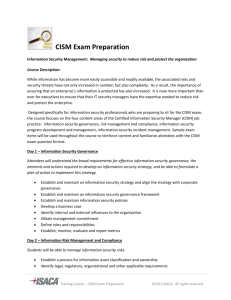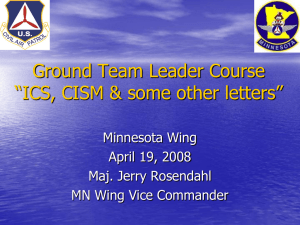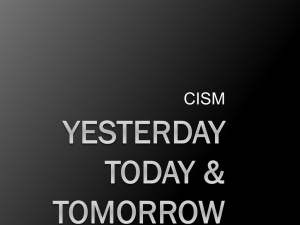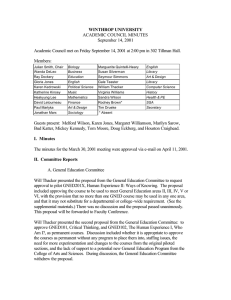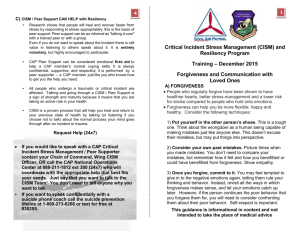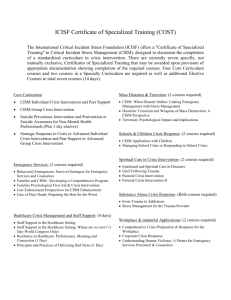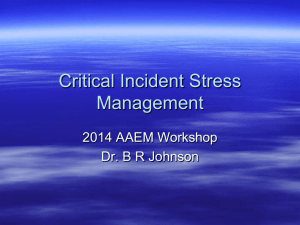CISM Coordinator/Leader Checklist: Roles & Responsibilities
advertisement
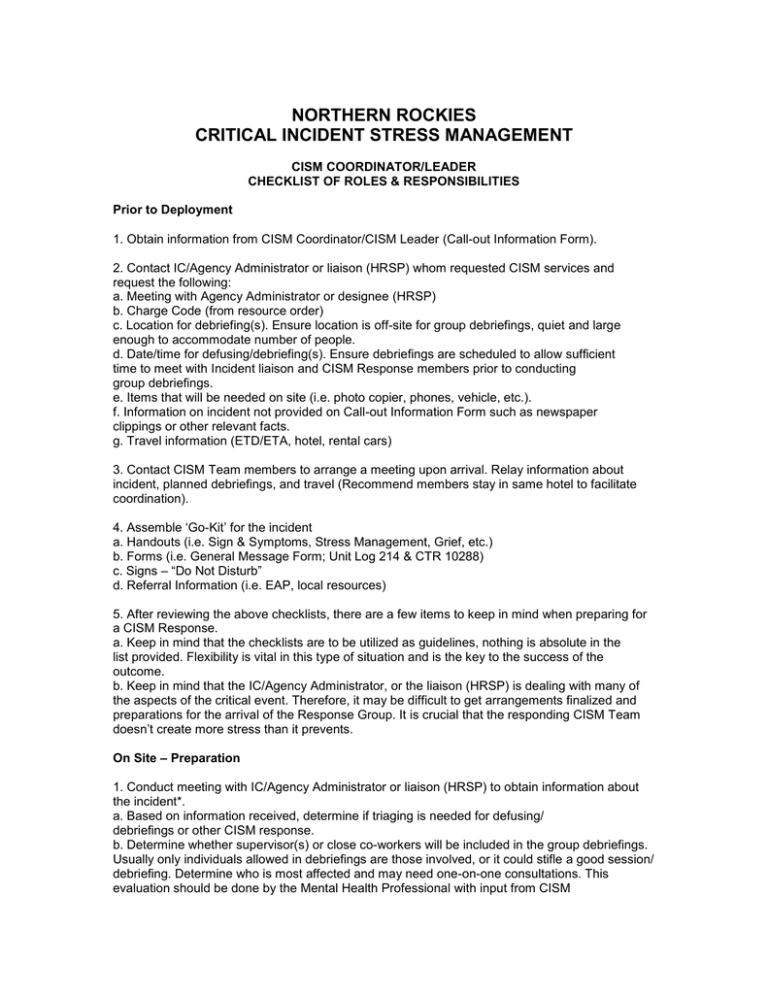
NORTHERN ROCKIES CRITICAL INCIDENT STRESS MANAGEMENT CISM COORDINATOR/LEADER CHECKLIST OF ROLES & RESPONSIBILITIES Prior to Deployment 1. Obtain information from CISM Coordinator/CISM Leader (Call-out Information Form). 2. Contact IC/Agency Administrator or liaison (HRSP) whom requested CISM services and request the following: a. Meeting with Agency Administrator or designee (HRSP) b. Charge Code (from resource order) c. Location for debriefing(s). Ensure location is off-site for group debriefings, quiet and large enough to accommodate number of people. d. Date/time for defusing/debriefing(s). Ensure debriefings are scheduled to allow sufficient time to meet with Incident liaison and CISM Response members prior to conducting group debriefings. e. Items that will be needed on site (i.e. photo copier, phones, vehicle, etc.). f. Information on incident not provided on Call-out Information Form such as newspaper clippings or other relevant facts. g. Travel information (ETD/ETA, hotel, rental cars) 3. Contact CISM Team members to arrange a meeting upon arrival. Relay information about incident, planned debriefings, and travel (Recommend members stay in same hotel to facilitate coordination). 4. Assemble „Go-Kit‟ for the incident a. Handouts (i.e. Sign & Symptoms, Stress Management, Grief, etc.) b. Forms (i.e. General Message Form; Unit Log 214 & CTR 10288) c. Signs – “Do Not Disturb” d. Referral Information (i.e. EAP, local resources) 5. After reviewing the above checklists, there are a few items to keep in mind when preparing for a CISM Response. a. Keep in mind that the checklists are to be utilized as guidelines, nothing is absolute in the list provided. Flexibility is vital in this type of situation and is the key to the success of the outcome. b. Keep in mind that the IC/Agency Administrator, or the liaison (HRSP) is dealing with many of the aspects of the critical event. Therefore, it may be difficult to get arrangements finalized and preparations for the arrival of the Response Group. It is crucial that the responding CISM Team doesn‟t create more stress than it prevents. On Site – Preparation 1. Conduct meeting with IC/Agency Administrator or liaison (HRSP) to obtain information about the incident*. a. Based on information received, determine if triaging is needed for defusing/ debriefings or other CISM response. b. Determine whether supervisor(s) or close co-workers will be included in the group debriefings. Usually only individuals allowed in debriefings are those involved, or it could stifle a good session/ debriefing. Determine who is most affected and may need one-on-one consultations. This evaluation should be done by the Mental Health Professional with input from CISM Team members. 2. Conduct meeting with CISM Team members to provide information about the incident, obtain information about their CISM experience, and plan debriefings. Develop debriefing strategy by addressing the following*: a. Assign tasks to group members (i.e. stages of debriefing, doorkeeper). b. Determine room arrangement and seating position of the group. 3. Be aware of the possible need for one-on-one consultations. 4. Purchase items needed for debriefing (i.e. refreshments, Kleenex). Post Debriefing 1. Mental Health Professional conducts an after action review with CISM Team members to discuss group process (i.e. what went well, lessons learned)*. 2. Determine if group members are „okay‟ or if they need to be debriefed*. 3. Mental Health Professional determines the need for one-on-one consultations, phone calls, or referrals. 4. Follow-up with IC/Agency Administrator or liaison (HRSP) about the outcome of the CISM. 5. Prepare and submit after action report to CISM Coordinator. Appendix 3 CISM Response Checklist Response time and commitment of members: Departure Date Arrival Date Team Members: Activities Logistics � Debriefings �Working with health � One on One's � Gather/dissemination of care professionals �Working with outside agency information �Working with families � Fitness for duty recommendations � Phones �Computer �Copy Machine � Rental Car � Lodging �Meals � Travel �P-codes � Briefing for incident upon arrival � Current (expected) Weather �Radios �Work Space �Red Bags �Gear specific to incident � Sleeping Bags and tents Approximately how many people were directly affected by the incident. How has the event affected incident personnel? Appendix 4 CISM Leader On-Site Checklist �Meet with group prior to going on-site where possible � Keep CISM Coordinator informed. • Look for past events that may be interfering with present incident. �Debrief team members on assessment of incident or meeting with IC/Agency Administrator, or liaison (HRSP). �Organize CISM Team. �Develop and request resources as needed. �Meet outside agency representatives/CISM/Health Care Professionals. �Re-evaluate current plan. • What • What • What • What is going well? is not working well? needs revisiting? needs to be done now? □ Close out with appropriate local officials who initiated the order �Close out with CISM Team members/debriefing • What • What • What • What went well? did not work? do we do next time? do we do now? CISM Coordinator/Leader Contact List Return to CISM Coordinator Contact person(s) at incident (first arrival). Best contact times Phone numbers: Work Home Cell Pager Liaison with Agency Representative (HRSP) Best contact times Phone numbers: Work Home Cell Pager Other Contacts (Multi-Agency Incident?) Best contact times Phone numbers: Work Home Cell Pager Are local CISM resources available? Y N What CISM has been done or planned before CISM Response arrival? CISM Contacts (Multi-Agency Incident?) Best contact times Phone numbers: Work Home Cell Pager
